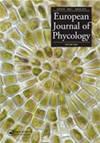自噬微藻的特性权衡:混合浮游动物难题
IF 1.7
4区 生物学
Q2 MARINE & FRESHWATER BIOLOGY
引用次数: 4
摘要
本文章由计算机程序翻译,如有差异,请以英文原文为准。
Trait trade-offs in phagotrophic microalgae: the mixoplankton conundrum
Analysis of trait trade-offs, through which physiological traits requiring common resources are ‘traded’ to optimize competitive advantage, provides a route to simplify and more readily understand the complexities of ecology. The concept of trait trade-offs has found favour in plankton research, especially directed at phytoplankton, defined here as phototrophs incapable of phagotrophy. Mixoplankton, defined as protists that combine phototrophy and phagotrophy, are now recognized as being widespread and significant members of the protist plankton community; many photoflagellate ‘phytoplankton’ are actually mixoplankton, as are many ‘(microbial) zooplankton’. Mixoplankton might be expected to be dominant, being able to exploit different trophic strategies while simultaneously eliminating competitors. That mixoplankton are not dominant suggests that physiological trait trade-offs erode their apparent competitive edge. We present a systematic analysis of potential trait trade-offs in phototrophic protists focused on mixoplankton. We find no clear evidence to support trait trade-off arguments in plankton research, except perhaps for acquired phototrophy in mixoplanktonic ciliates versus zooplanktonic ciliates. Our findings suggest that the presence of various mixoplankton throughout the surface ocean waters is most likely explained by factors other than trait trade-offs. Diversities in mixoplankton form and function thus reflect that evolution of these organisms from very different lineages, provide them with advantages to function competitively in mature ecosystems with complex trophic interplay. Indeed, the complexity of those lineages is inconsistent with core trait trade-off definitions; there is no single ancestral mixoplankton nor a common environment supporting trait-trade-off-directed evolution. HIGHLIGHTS ● Trait trade-offs do not explain the breadth of mixoplankton ecophysiological capabilities. ● Diversity of mixoplankton form and function reflects phylogenetic diversity. ● Only one potential trait trade-off was identified which was for ciliates that steal chloroplasts.
求助全文
通过发布文献求助,成功后即可免费获取论文全文。
去求助
来源期刊

European Journal of Phycology
生物-海洋与淡水生物学
CiteScore
4.80
自引率
4.20%
发文量
37
审稿时长
>12 weeks
期刊介绍:
The European Journal of Phycology is an important focus for the activities of algal researchers all over the world. The Editors-in-Chief are assisted by an international team of Associate Editors who are experts in the following fields: macroalgal ecology, microalgal ecology, physiology and biochemistry, cell biology, molecular biology, macroalgal and microalgal systematics, applied phycology and biotechnology. The European Journal of Phycology publishes papers on all aspects of algae, including cyanobacteria. Articles may be in the form of primary research papers and reviews of topical subjects.
The journal publishes high quality research and is well cited, with a consistently good Impact Factor.
 求助内容:
求助内容: 应助结果提醒方式:
应助结果提醒方式:


